Serpentine PEMFC Fuel Cell, ANSYS Fluent CFD Simulation
$270.00 $135.00 Student Discount
- The problem numerically simulates a Serpentine Fuel Cell using ANSYS Fluent software.
- We design the 3-D model with the Design Modeler software.
- We mesh the model with ANSYS Meshing software, and the element number equals 9,396,122.
- We use the Fuel Cell and Electrolysis Model to define a fuel cell.
- We used the PEMFC sub-model to define a proton exchange membrane fuel cell.
- We used the Species model to define H2, O2, and H2O.
To Order Your Project or benefit from a CFD consultation, contact our experts via email (info@mr-cfd.com), online support tab, or WhatsApp at +44 7443 197273.
There are some Free Products to check our service quality.
If you want the training video in another language instead of English, ask it via info@mr-cfd.com after you buy the product.
Description
Serpentine Fuel Cell, Proton Exchange Membrane Fuel Cell, PEMFC, CFD Simulation, ANSYS Fluent Tutorial
Description
In this project, we perform the numerical simulation of a Serpentine Fuel Cell using ANSYS Fluent software.
This product is the 2nd chapter of the Fuel Cell Training Course.
A fuel cell is an energy conversion device that converts the chemical energy of fuel into electrical energy. A fuel cell produces electricity through a chemical reaction. Fuel cells have two electrical poles (electrodes) called anode and cathode. These chemical reactions take place in these electrodes and lead to the production of electricity.
In addition, fuel cells have an electrolyte and a catalyst. The electrolyte layer is used to transport charged particles (ions) between the electrodes, while the catalyst layer increases the speed of reactions in the electrode layers. The hydrogen is fed to the fuel cell as the main fuel. However, oxygen is also required for the reaction to take place.
One of the most important advantages of the fuel cell is that electricity is produced with the least amount of pollution. In fact, most of the oxygen and hydrogen input to the fuel cell is eventually released in the form of a harmless byproduct, that is, water.
Another advantage of fuel cell is that fuel cell produces electricity chemically and not by combustion reaction. Therefore, the fuel cell is more efficient in producing energy from fuel. There are different types of fuel cells. In this project, we have simulated the proton exchange membrane fuel cell (PEMFC).
Fuel cells have gas flow channels with different configurations. In this project, we used a serpentine fuel cell. In a serpentine fuel cell, the gas flow channels have a spiral path.
Fuel Cell Methodology
We simulated this project based on the CFD method by ANSYS Fluent software. First, we designed the geometry of the model in 3D using Design Modeler software. The computational domain of the model is related to the interior space of a fuel cell. Then, we meshed the model using ANYS Meshing software. The meshing is unstructured, and 9,396,122 cells are generated. Finally, we performed the simulation process in Fluent software.
For this simulation, we used the fuel cell model in Ansys Fluent software. The fuel cell model is an add-on module in Ansys Fluent software.
There are three different fuel cell add-on modules available in the software. We have used the fuel cell and electrolysis model. Here, there are three submodels. We have used the PEMFC model.
In the fuel cell model setting, we determine the different layers of the fuel cell. These layers include the cathode and anode layers, along with the electrolyte layer. Each of the anode and cathode layers consists of current collectors, gas diffusion layers (electrode layers), catalyst layers, and flow channels.
Since we used the fuel cell model, the species transport model is automatically activated. The species transport model defines the species present in the fuel cell, including H2, O2, and H2O.
Fuel Cell Conclusion
After conclusion, we have obtained the contours related to electric potential, protonic potential, water content, current flux density magnitude, transfer current, and mass fraction of H2, O2, and H2O.
The H2, O2, and H2O mass fraction contours show that hydrogen enters from the anode side, oxygen enters from the cathode side, and water is produced in the cathode section. This behavior is exactly according to the functional mechanism of the PEMFC fuel cell system.
When we use the fuel cell model, some user-defined scalars (UDS) are enabled. Here, we obtained the contours of electric potential (scalar 0), protonic potential (scalar 1), and water content (scalar 3). These contours show that the potential equations of the fuel cell model are solved correctly. Hence, the effect of electrons and protons in fuel cell layers is understandable. In addition, the production of water in the fuel cell is also significant.
Also, when we use the fuel cell model, several user-defined memories (UDM) are enabled. Here, we obtained contours of current flux density magnitude (user-defined memory 3) and transfer current (user-defined memory 13). These contours show that the current is generated based on the voltage we defined for the fuel cell.
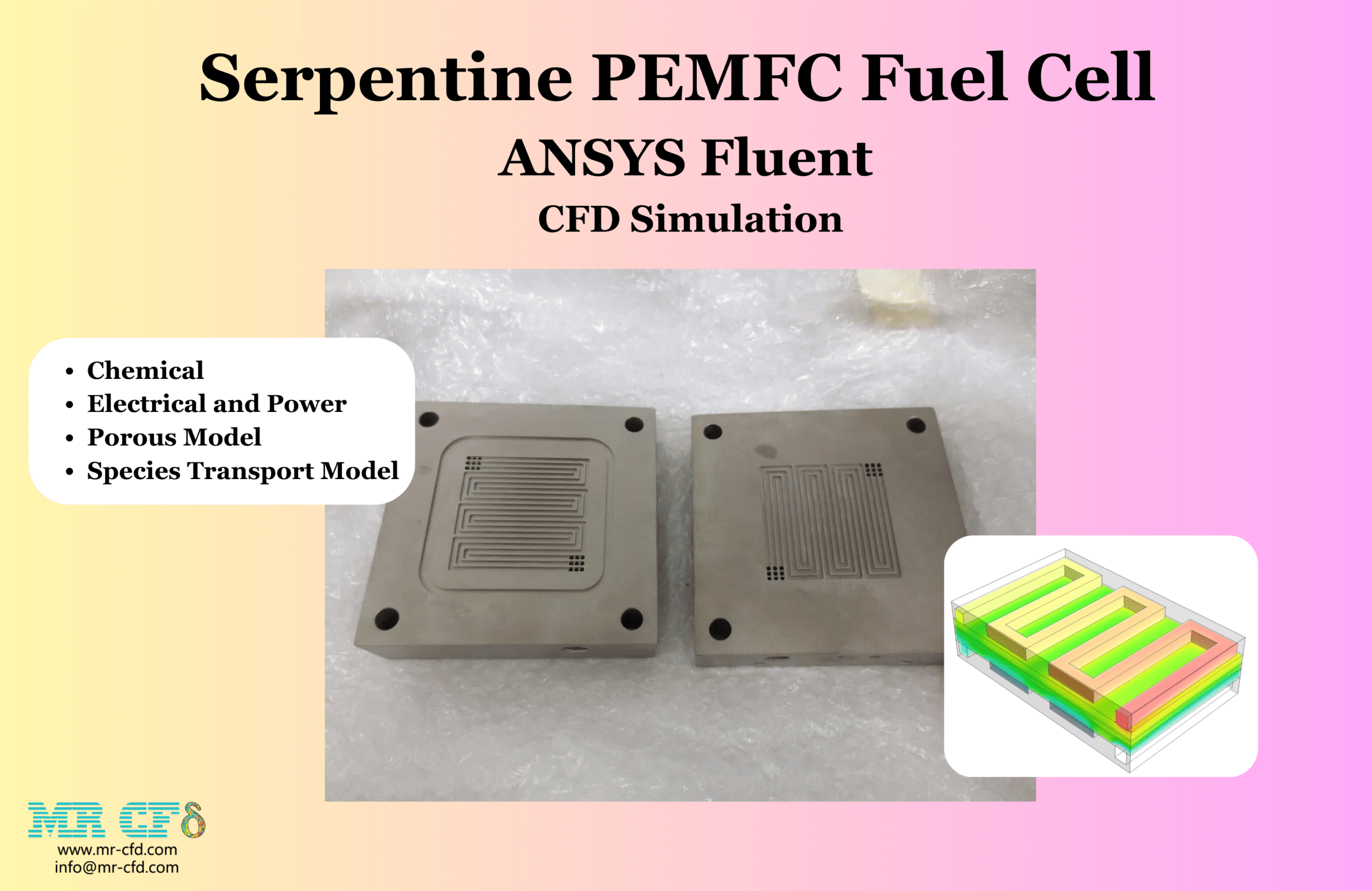
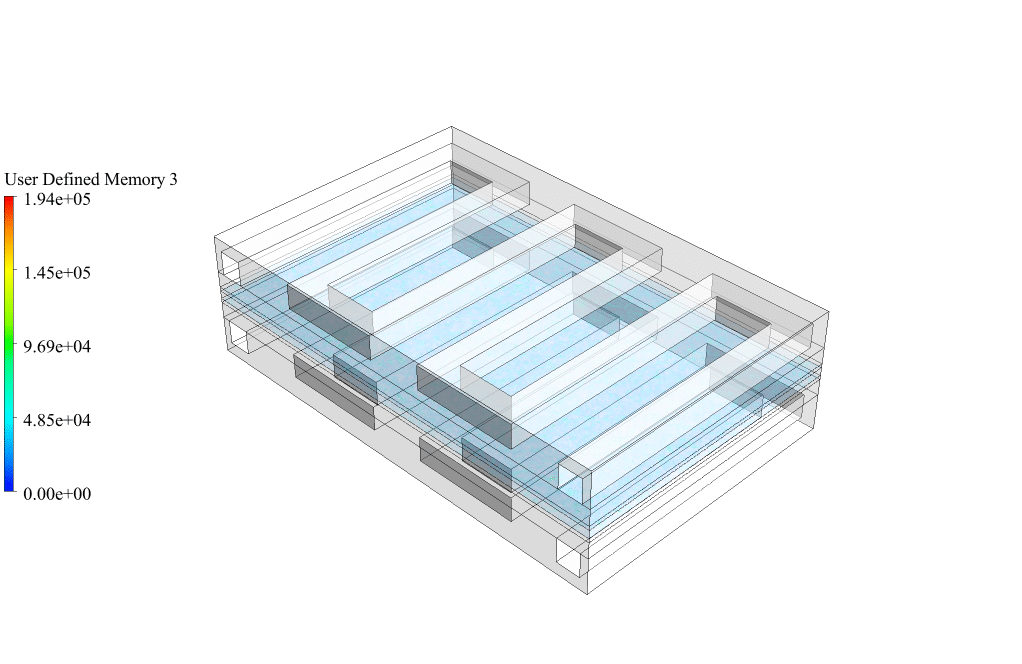
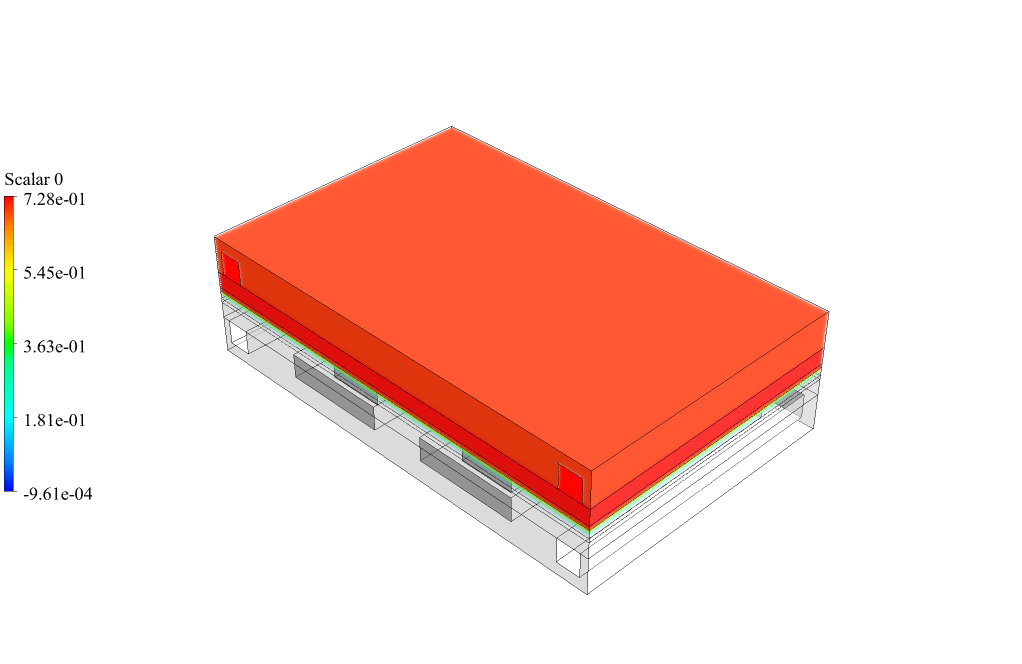
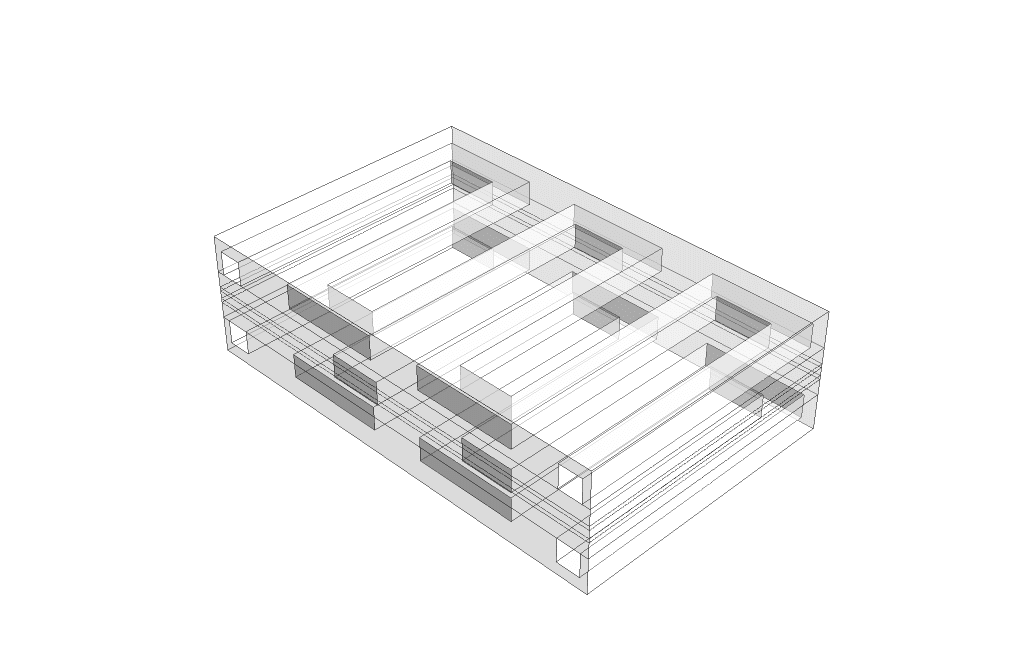
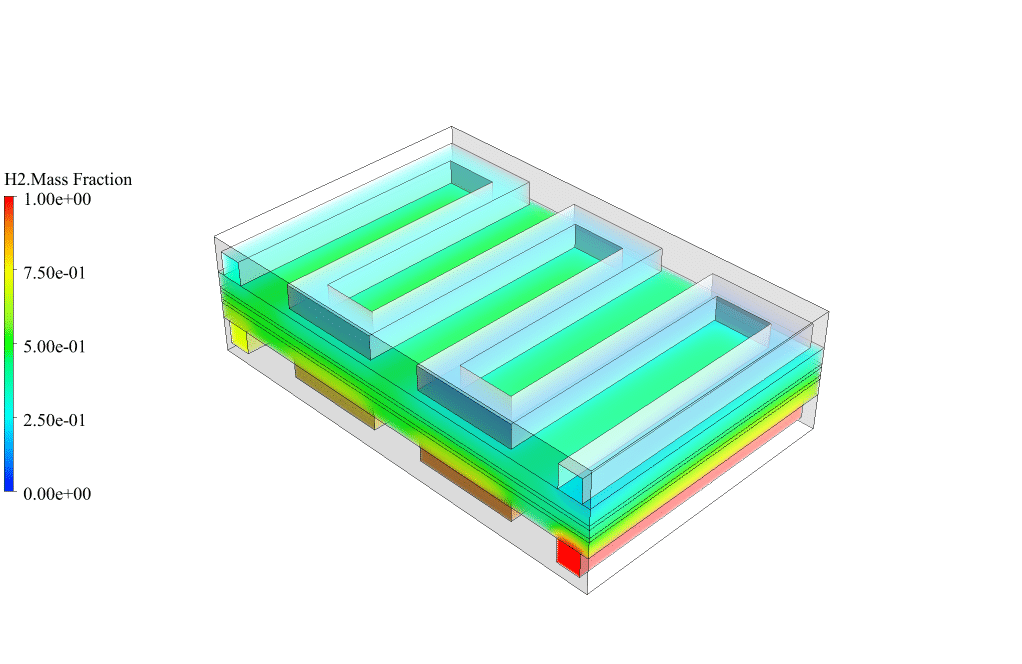
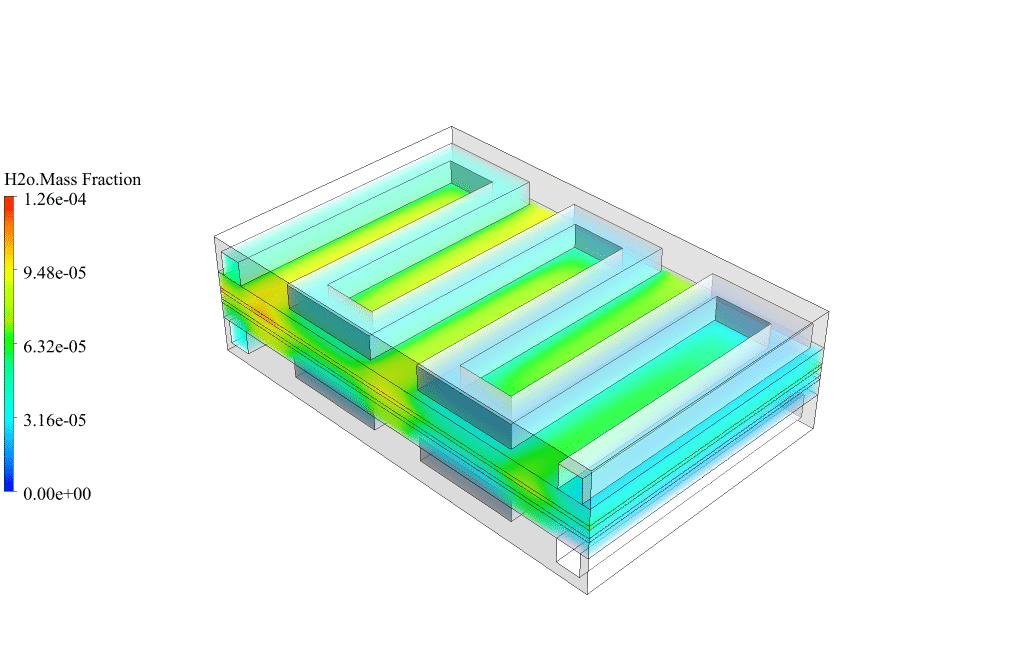
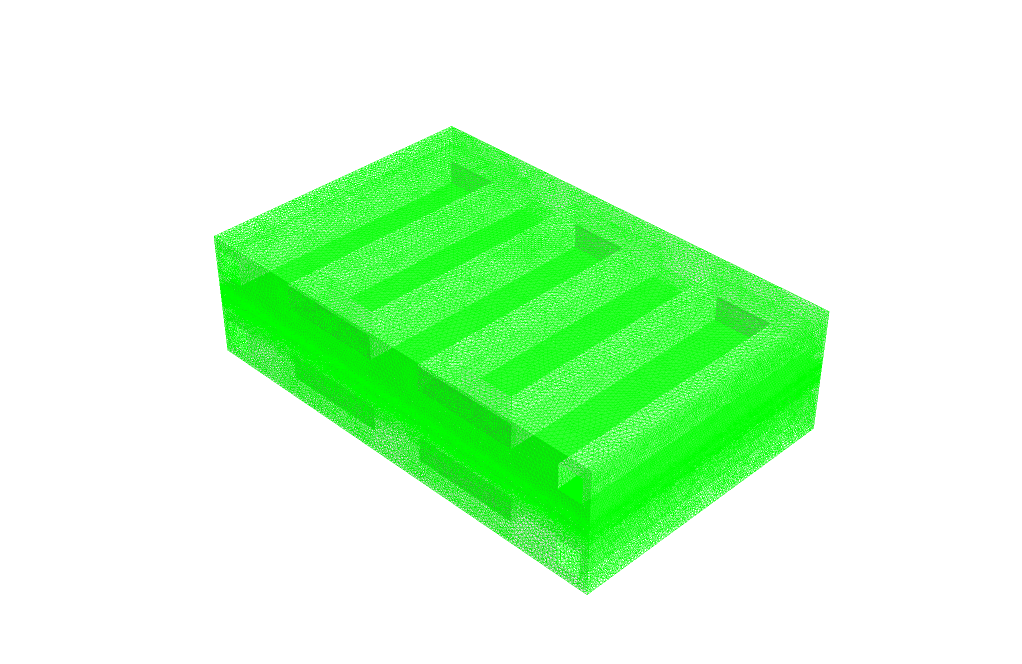
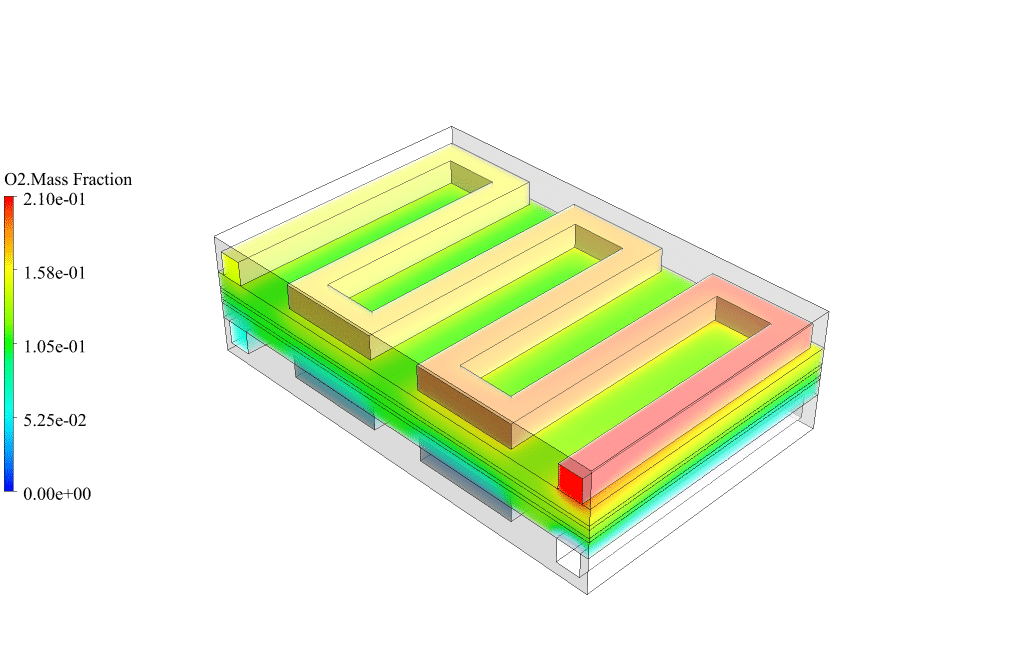
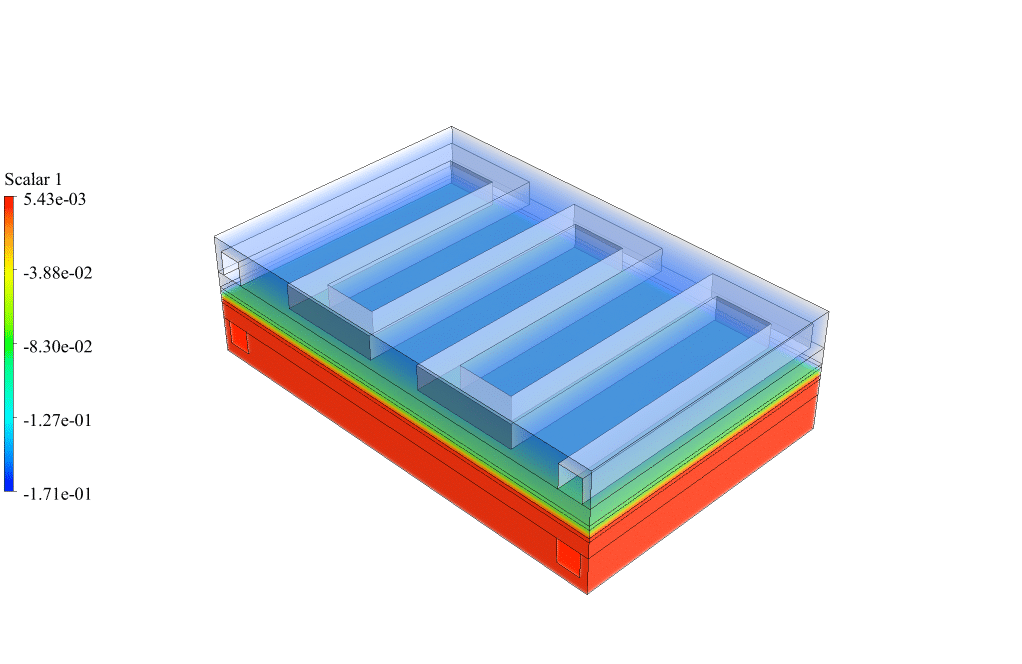
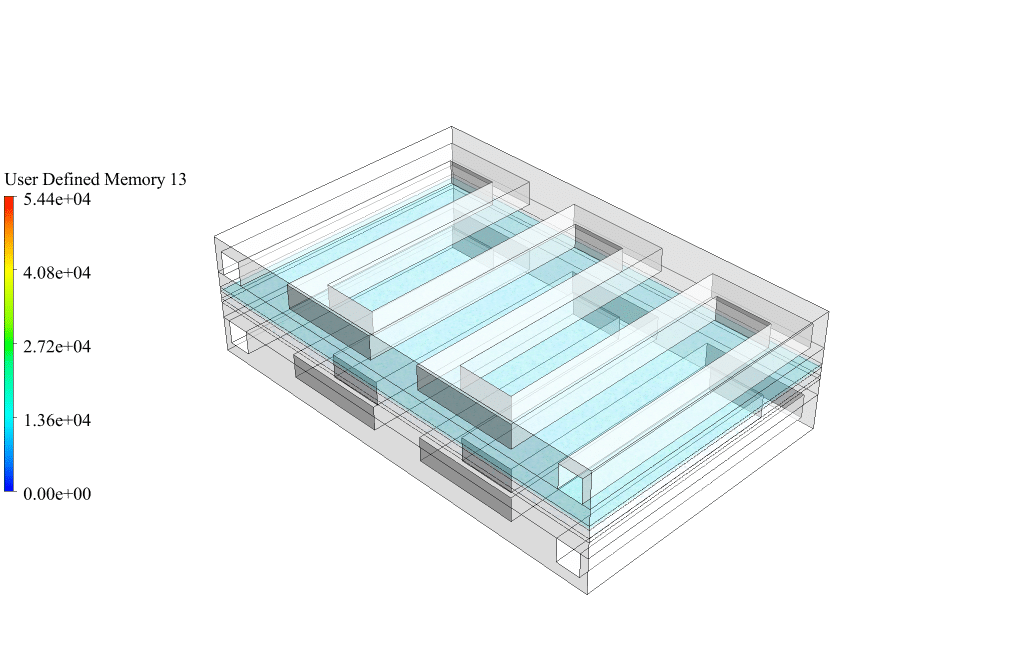
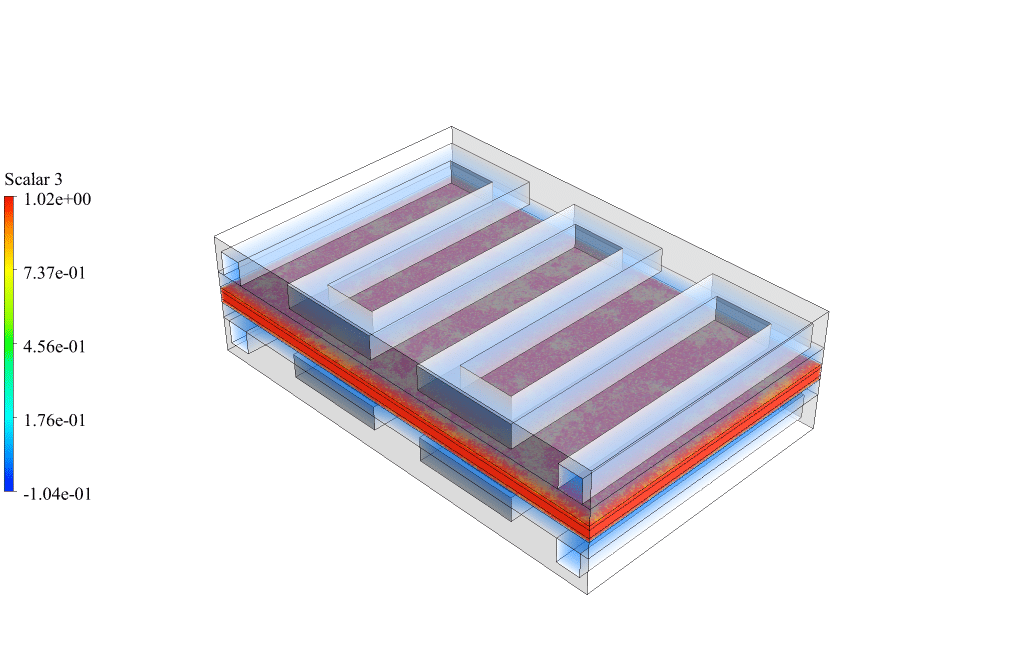

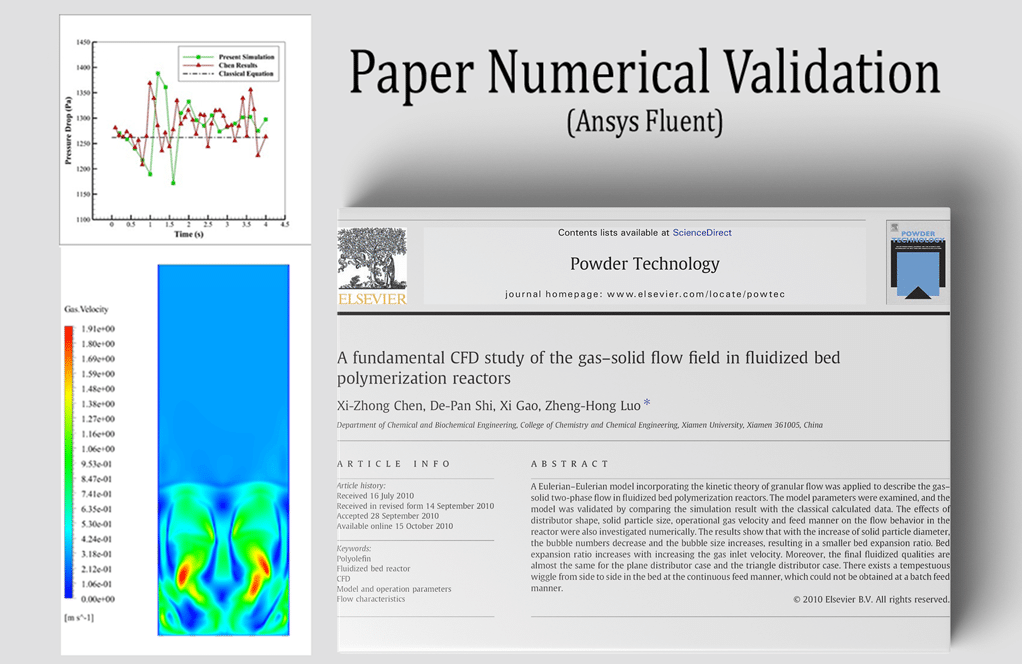


Josue Rolfson I –
I’ve always been fascinated by sustainable energy solutions; it’s heartwarming to see the advancements in fuel cell technology. The simulation’s thorough approach brings out the intricate details of the PEMFC, providing immense learning value to aspirants like me interested in green tech innovation. The accuracy of your analysis is commendable; interpreting these complex reactions with such clarity is no lesser than an art. Thank you for sharing this insightful journey into the realm of fuel cells through CFD!
MR CFD Support –
Thank you for your kind review and interest in sustainable energy solutions. We’re thrilled to hear that the Serpentine PEMFC Fuel Cell simulation has been insightful and valuable in your journey towards understanding green technological innovations. Your acknowledgment motivates us to keep providing high-quality learning experiences aligned with the latest advancements in the field. If you ever have more feedback or need further assistance regarding our simulation products, don’t hesitate to reach out!
Dr. Aniya Hills –
The detail and clarity in the tutorial for setting up the serpentine PEMFC fuel cell simulation in ANSYS Fluent was unmatched. I particularly appreciate how the species transport model was automatically activated using the fuel cell module, streamlining the entire simulation process. The step-by-step guidance on defining the different layers within the fuel cell was highly intuitive and provided a solid understanding of the cell’s intricate workings. It’s fascinating how the reactants and products’ flow pathways were visualized, showcasing the practical realization of PEMFC’s functionality.
MR CFD Support –
Thank you so much for your kind review and appreciation of the serpentine PEMFC fuel cell simulation using ANSYS Fluent. We’re delighted to hear that the integrated features and detailed guidance provided by the fuel cell module made a substantial difference in your learning experience. Understanding such a complex subject can be challenging, and we strive to provide clarity and depth in our training materials. It’s rewarding to learn that our efforts have been well received and instrumental in enhancing your comprehension of fuel cell simulations.
Martine Weimann –
Wow, the detail put into simulating the serpentine PEMFC fuel cell is impressive, specifically the intricate modeling done on the different layers and the chemical reactions occurring. It’s clear that this project could really aid in understanding the complexities of fuel cell operations, and potentially improve design and efficiency!
MR CFD Support –
Thank you for your positive feedback! We’re so pleased to hear that you appreciate the comprehensive modeling and simulation work behind the Serpentine PEMFC fuel cell project. Our team strives to provide in-depth analysis to help enhance understanding and development in the field of energy conversion devices. If you’re looking for more information or have any further questions, don’t hesitate to reach out.
Kennedi Runte Sr. –
The project and results appear impressively detailed. I’ve learned a lot about the PEMFC system by following through the tutorial. The water production aspect and the potential equations’ adequacy were particularly well-explained.
MR CFD Support –
Thank you for your kind words! We’re thrilled to hear that our tutorial on the Serpentine PEMFC Fuel Cell helped enhance your understanding of the system. It’s fantastic to know the explanations on water production and potential equations were clear and informative. Your feedback is greatly appreciated!
Lizeth Williamson –
After reading through the description of the Serpentine PEMFC Fuel Cell Simulation, I am thoroughly impressed with the depth of analysis and the comprehensive coverage of the fuel cell’s operational aspects within the simulation. It’s quite fascinating to see how CFD tools can so accurately model the physics of such complex systems to provide insights that lead to more efficient designs.
MR CFD Support –
We sincerely appreciate your kind words and enthusiasm about the Serpentine PEMFC Fuel Cell simulation project! It’s rewarding for us to hear that our efforts to provide an illustrative and thorough analysis meet the expectations of our users. Understanding the intricate mechanisms in such a complex system plays a pivotal role in advancing fuel cell technology, and we’re glad our software could depict this accurately for you. Thank you once again for your positive feedback!
Lonnie Deckow –
Incredible learning tool for understanding Serpentine PEMFC systems! The tutorial explained complex topics like chemical reactions and potential gradients in an accessible way. I was particularly impressed with how the simulation visualized the flow and production of water. Well done!
MR CFD Support –
Thank you for your kind words! We’re thrilled to hear that our tutorial on Serpentine PEMFC was helpful in explaining the complex concepts in a clear and visual manner. Your feedback is greatly appreciated, and we’re glad that you found the simulation effective. If you require more assistance or information, feel free to reach out.
Dr. Gust Volkman V –
Finally nailed my presentation on PEMFC technology thanks to this detailed CFD simulation! The quality of the graphs and the detailed analysis gave me deep insights into fuel cell behavior. Much appreciated!
MR CFD Support –
Thank you so much for your kind words! We’re glad to hear our simulation was instrumental for your presentation on PEMFC technology. If there’s anything else we can help you with or if you’re looking for more resources, please let us know!
Jamie Schinner –
The simulation clarified the PEMFC fuel cell operation beautifully! The visuals made it easy to understand how H2 and O2 transform into water and electricity.
MR CFD Support –
Thank you for your positive feedback! It’s fantastic to know the simulation’s visuals helped illustrate the PEMFC fuel cell’s processes clearly. Your understanding is exactly what we aimed to facilitate with our training module.
Marcelino Donnelly –
I am utterly impressed with the depth and detailing of this Serpentine PEMFC simulation. The comprehensiveness of the tutorial is remarkable, demonstrating not just the setup but how each step contributes towards the finality of the simulation. Understanding the electric potentials and protonic potentials and being able to visualize the reactions to the point of water production are indicative of a high practical learning experience. Kudos to MR CFD for putting together such an educational resource.
MR CFD Support –
Thank you so much for your kind words! We are truly glad to hear that you found our Serpentine PEMFC Fuel Cell tutorial comprehensive and insightful. Our goal is to provide in-depth resources that are not only informative but also practical for users to gain a complete understanding of every aspect of the simulation. We appreciate you taking the time to leave such a positive review and for recognizing our efforts. If you have any further feedback or inquiries, please don’t hesitate to reach out. Happy simulating!
Rosalia Collier –
The level of detail in the Serpentine PEMFC simulation process is impressive. The methodology outlined provided great insights into the setup and execution, and it’s great to see the comprehensive approach taken to achieve such accurate results.
MR CFD Support –
Thank you for your positive feedback! We strive to provide detailed and thorough tutorials so that users can replicate and understand the intricacies involved in such complex simulations. It’s rewarding to hear that the efforts put into the structure and delivery of the tutorial are appreciated.
Shaina Cummerata –
The module seems quite comprehensive and detailed! I have gone through the course and must say it is very intricate. However, could you explain a bit more about how the material layers like cathode and anode layers are defined in the model? I would like to understand this particular setup process more clearly.
MR CFD Support –
In the ANSYS Fluent fuel cell model, the cathode and anode layers are defined using the concept of zones within the simulation domain. Each zone corresponds to a different part of the cell, like the anode, cathode, and electrolyte. Through the ‘Fuel Cell & Electrolysis’ module settings, you assign material properties like electrical and thermal conductivity to each zone, making sure they accurately represent their physical counterparts. The properties will then factor into the solution of the potential equations and consequently affect the prediction of current and potential distributions within the cell.
Ariel Dare –
The project description did an excellent job detailing how the Serpentine PEMFC Fuel Cell operates and its simulation through ANSYS Fluent. It is fascinating to understand the conversion of chemical energy into electrical energy with minimal pollution, and the comprehensive explanation of the simulation’s methodology and outcomes, especially highlighting the significance of the generated potential contours and current, is deeply appreciated. This gives a vivid sense from steps of geometry creation to final flow patterns. What I’m taking away from this is that the intricate design and careful CFD simulation can truly bring to light the performance capabilities of such complex systems as PEMFCs.
MR CFD Support –
Thank you very much for sharing your positive experience! We’re glad that you found the explanation of the Serpentine PEMFC Fuel Cell simulation comprehensive and the portrayal of its energy conversion processes engaging. It is wonderful to hear that our detailed description aided in your understanding of PEMFC systems and CFD simulations. We pride ourselves on providing clear and insightful information regarding the performance and operations of fuel cells and we’re pleased that this came across in our project description. Your feedback is greatly appreciated and motivates us to continue delivering high-quality content. If there’s anything else you’re curious about or would like to see more of, please feel free to let us know!
Cindy Ledner –
The project looks comprehensive! What specific materials did you set for the electrolyte and catalyst layers, and what properties were ascribed to them?
MR CFD Support –
The materials for the electrolyte and catalyst layers were defined according to the applicable properties for a PEMFC. For the electrolyte, a proton-conducting membrane with characteristics like Nafion might have been used, incorporating properties like proton conductivity and permeability to water. The catalyst likely includes platinum on a carbon support for the anode and cathode, with properties including electrical conductivity and catalytic activity being set in the software. Using accurate material properties ensures realistic simulation results for the PEMFC performance.
Ms. Alvena Rutherford –
I truly appreciated the depth of information in the ‘Serpentine PEMFC Fuel Cell, ANSYS Fluent CFD Simulation’ training material. The tutorial was enlightening, showing the stepwise breakdown of setting up fuel cell components within ANSYS Fluent. This incurred a deep understanding of fuel cells, the importance of their design, and how they function. Particularly, the clarity around establishing current flux density magnitude and transfer current using user-defined memories helped a lot!
MR CFD Support –
Thank you for the sincere complement of our ‘Serpentine PEMFC Fuel Cell, ANSYS Fluent CFD Simulation’ tutorial. It’s incredibly rewarding to see our customers walk away with a deeper comprehension of fuel cell simulations. We’re pleased the material was clear and beneficial for your learning experience, especially in unraveling complex phenomena associated with fuel cell operations. We strive to provide valuable and intuitive training, enhancing learning for professionals and students. Looking forward to serving you with more high-quality educational content!
Lavern Auer –
The detailed results demonstrate the fuel cell’s functionality well. Great work!
MR CFD Support –
We truly appreciate your positive feedback on our Serpentine PEMFC Fuel Cell CFD Simulation product. Reviews like yours motivate us to maintain high-quality standards for our learning materials. Thank you for taking the time to share your experience!
Prof. Lucas Sipes –
I am extremely impressed with the detailed simulation of the Serpentine Fuel Cell in ANSYS Fluent. The comprehensive methodology and conclusion derived from the extensive CFD analysis are commendable. Not only has it brought clarity to the different layers of the fuel cell like the anode, cathode, and electrolyte, but it also provided great insight into the behavior of hydrogen, oxygen, and water within the system. The fuel cell model has adeptly captured the essentials of the PEMFC operation and demonstrated the production of electricity with utmost efficiency. Really appreciated the visualization of potential distributions and proton exchange processes in the cell that brought theory to life.
MR CFD Support –
Thank you for your fantastic review! We’re thrilled to hear that our Serpentine PEMFC Fuel Cell simulation in ANSYS Fluent met your expectations and provided valuable insights. Our team strives to deliver detailed and accurate simulations to help users understand and visualize the complex workings of fuel cells. We appreciate your complement on the visualization of electric and protonic potentials as well as the species transport within the cell. Your feedback is very encouraging for our team. Thank you for choosing our tutorial, and we look forward to possibly assisting you with any future learning endeavors!
Frederik Walsh –
I was truly impressed with how detailed the simulation was for the Serpentine PEMFC Fuel Cell. The ability to understand the production of water in the cathode section from the mass fraction contours was aligned with theoretical expectations. The tutorial made complex concepts more accessible.
MR CFD Support –
Thank you for noticing the level of detail we strive for in our simulations. We’re glad to hear that our tutorial was able to clarify the complex processes involved in the PEMFC Fuel Cell and make the information accessible. It’s great to know you found the contour illustrations helpful for understanding the production of water within the cathode section. We appreciate your positive feedback!
Rebekah Zieme –
The simulation outcomes you’ve shared are splendid! The detailed analysis of the electrical and chemical performance of the PEMFC serpentine fuel cell vividly demonstrates its efficiency and operational viability. The visual representation through the contours of electric potential, protonic potential, and water content is extremely insightful. It’s engaging to see the chemical reactions of H2, O2, and H2O navigate through the fuel cell layers, culminating in effective electricity production. Your project perfectly encapsulates the sophisticated reaction mechanisms within such energy devices.
MR CFD Support –
Thank you for your positive feedback! We’re thrilled to know that our simulation of the Serpentine PEMFC met your standards and that you found the electric and protonic potential contours, along with the product water content analysis, to be insightful. It’s very motivating to hear that the representations and results helped in understanding the operational viability of the fuel cell. We appreciate you taking the time to review and compliment our project.